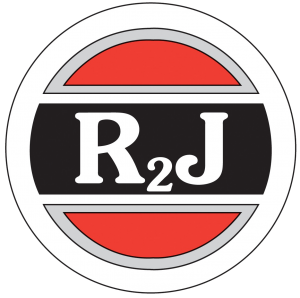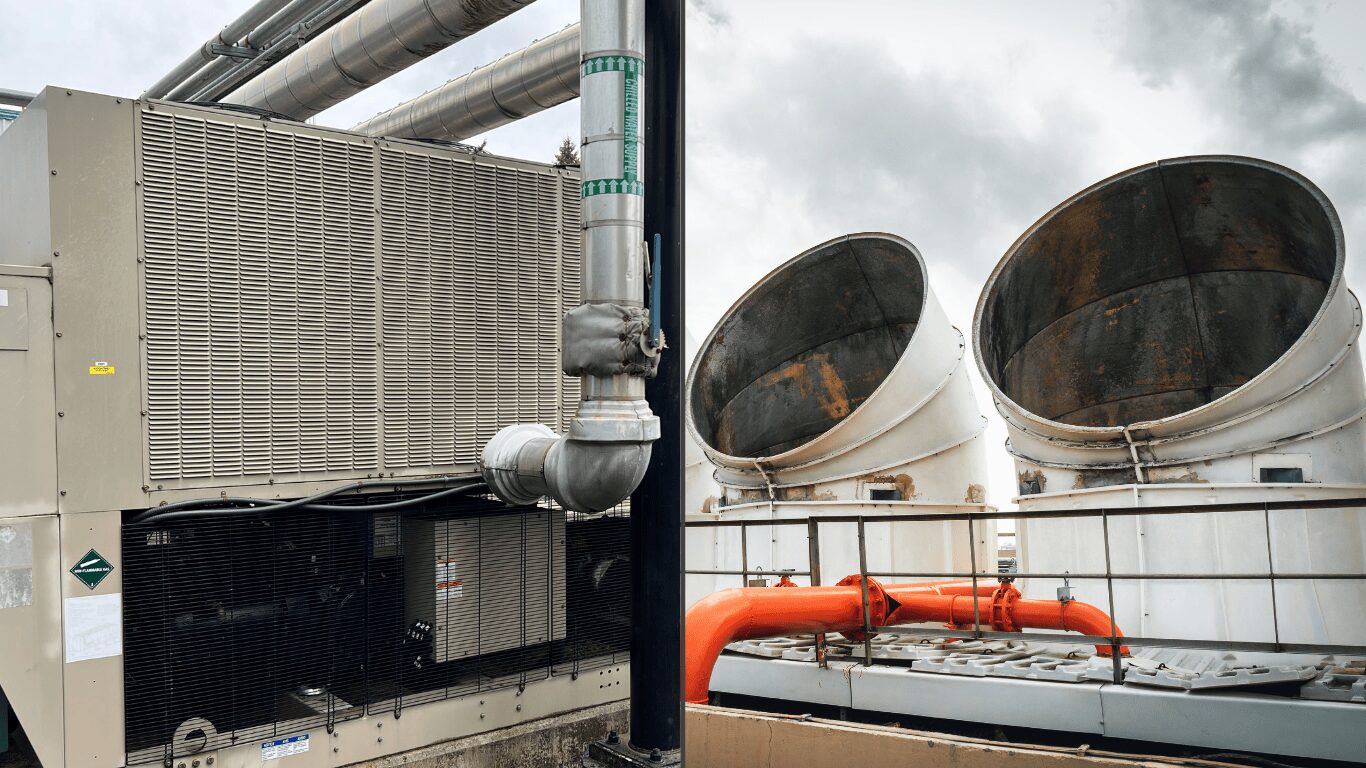Cooling Tower vs Chiller: Which One Do You Need?
Aug 31, 2022Cooling systems come in many forms, but two of the most common are the cooling tower and the chiller. At first glance, they seem to do the same thing: remove heat from a building or process. In reality, they handle completely different parts of the cooling process. Understanding the difference between a cooling tower vs chiller helps operators make smarter decisions about system design, energy use, and long-term maintenance.
In facilities like power plants, food processing sites, or large commercial buildings, the right cooling setup can make a huge difference in efficiency and cost. Before choosing one, it’s important to understand how each system works and the role it plays in keeping your operation running smoothly.
How Cooling Towers Work
A cooling tower removes heat from water through evaporative cooling. When warm water from a system enters the tower, part of it evaporates into the air. That evaporation carries away heat, leaving the remaining water cooler before it returns to the system.
The Cooling Process
- Hot water enters the tower: The heated water flows through fill media, which spreads it into thin films or droplets.
- Air flows through the tower: Fans or natural draft pull cool air through the structure, allowing heat to transfer from the water to the air.
- Evaporation removes heat: A small amount of water evaporates, reducing the temperature of the remaining water.
- Cooled water returns: The cooler water is pumped back into the system to absorb more heat during the next cycle.
Types of Cooling Towers
Many facilities use induced draft cooling towers or counterflow cooling towers, both engineered for efficient heat exchange. These designs are common in industrial processes and large-scale HVAC systems, where rejecting waste heat is critical for stable operation.
Why Water Treatment Matters
Water quality directly affects cooling efficiency. Without proper management, scale and biological growth can clog surfaces and reduce heat transfer. Regular chemical treatment keeps tower systems clean and efficient. To learn more about this, see our guide on cooling tower treatment.
How Chillers Work
While cooling towers release heat into the air, chillers focus on removing heat from a process or building system. They work through a refrigeration cycle that transfers unwanted heat from one place to another using a closed loop of coolant.
The Basic Cycle
- Evaporator absorbs heat: Warm water or air passes through evaporator heat exchangers, where the system coolant absorbs heat and evaporates into gas form.
- Compressor increases pressure: The chiller unit compresses the refrigerant gas, raising its temperature and pressure.
- Condenser rejects heat: The hot gas moves through condenser heat exchangers, where heat is released to the surrounding air or water.
- Expansion valve reduces pressure: The refrigerant cools again, returning to liquid form and repeating the cycle.
Air Cooled vs. Water Cooled Chillers
- Air cooled chillers use fans to blow air over condenser coils, making them ideal for sites with limited water supply or smaller HVAC systems.
- Water cooled chillers use cooling water and often pair with cooling towers for higher efficiency in large-scale applications.
Both systems rely on precise heat transfer to achieve consistent, energy efficient performance across industrial and commercial environments.
Cooling Tower vs Chiller: Core Differences
Cooling towers and chillers often work hand in hand, but they perform very different jobs. The easiest way to think about it: a chiller removes heat, while a cooling tower rejects heat into the surrounding air. Together, they complete the cooling process, but each serves a unique purpose in how that heat moves through the system.
How Each Handles Heat
- Chiller: Absorbs heat from a process or space using refrigerant and a closed-loop system.
- Cooling Tower: Releases that absorbed heat from water into the air through evaporative cooling.
- Result: The chiller delivers precise temperature control, and the tower ensures that excess heat is safely discharged.
Temperature and Scale
- Chillers handle lower temperature ranges, often between 4°C and 15°C, suitable for industrial processes or HVAC systems needing precision.
- Cooling towers deal with warmer hot water, typically between 30°C and 40°C, and are used where large volumes of waste heat need to be dissipated.
Applications
- Chillers: Data centers, manufacturing lines, and food processing that demand precise temperature control.
- Cooling Towers: Power plants, large commercial buildings, and other large-scale HVAC systems where cost-effective heat transfer is the goal.
For guidance on what to monitor during routine checks, you can explore our detailed cooling tower maintenance guide.
Cooling Tower vs Chiller: Core Differences
Cooling towers and chillers often work hand in hand, but they perform very different jobs. The easiest way to think about it: a chiller removes heat, while a cooling tower rejects heat into the surrounding air. Together, they complete the cooling process, but each serves a unique purpose in how that heat moves through the system.
How Each Handles Heat
- Chiller: Absorbs heat from a process or space using refrigerant and a closed-loop system.
- Cooling Tower: Releases that absorbed heat from water into the air through evaporative cooling.
- Result: The chiller delivers precise temperature control, and the tower ensures that excess heat is safely discharged.
Temperature and Scale
- Chillers handle lower temperature ranges, often between 4°C and 15°C, suitable for industrial processes or HVAC systems needing precision.
- Cooling towers deal with warmer hot water, typically between 30°C and 40°C, and are used where large volumes of waste heat need to be dissipated.
Applications
- Chillers: Data centers, manufacturing lines, and food processing that demand precise temperature control.
- Cooling Towers: Power plants, large commercial buildings, and other large-scale HVAC systems where cost-effective heat transfer is the goal.
For guidance on what to monitor during routine checks, you can explore our detailed cooling tower maintenance guide.
Efficiency and Energy Use Considerations
Every facility wants to keep cooling reliable while lowering energy costs. When comparing air cooled chillers, water cooled chillers, and cooling towers, the difference often comes down to how each system manages heat and resources.
Energy Consumption
- Air cooled chillers are simpler to install but use more electricity, since fans work harder to reject heat directly to ambient air.
- Water cooled chillers, paired with cooling towers, are more energy efficient for large scale applications because water transfers heat better than air. However, they do consume more water.
- Cooling towers rely on evaporative cooling, which uses less energy but requires regular monitoring to manage water consumption and water quality.
Balancing Cost and Sustainability
Choosing the right combination of systems can lead to major cost savings and lower energy consumption. Facilities in regions facing water scarcity often lean toward air cooled systems, while others prioritize water-based setups to achieve maximum efficiency and long-term reliability.
Maintenance and System Care
Keeping chillers and cooling towers efficient comes down to routine attention. Even the best-designed systems lose performance when water quality, airflow, or internal surfaces aren’t maintained properly. Regular inspections and cleaning go a long way in preventing downtime and costly repairs.
What Operators Should Check
- Water quality: Poor treatment causes scale and corrosion, which block heat transfer surfaces.
- Fill media: Dirt or algae buildup limits air flow and evaporative cooling efficiency.
- System coolant: Low or contaminated coolant in a chiller unit can reduce capacity and stress compressors.
- Condenser and evaporator surfaces: Cleaning removes buildup that restricts flow and raises energy consumption.
Good Practices
Teams should schedule quarterly inspections, test water chemistry, and flush out deposits as needed. Proper cooling tower cleaning and water treatment not only prevent failures but also help maximize efficiency and extend system life.
Choosing the Right System
Every facility has its own cooling needs. Some require precise temperature control for production or data management, while others simply need to dissipate heat from heavy equipment. If your operation involves continuous, high-volume heat loads, a cooling tower is often the practical choice. For processes that demand tight temperature ranges and exact control, a chiller delivers better results.
The best approach often blends both: using a chiller to absorb heat and a tower to reject it efficiently. The key is to match system design with your environment, available water, and long-term energy goals.
Not sure which cooling system fits your operation best? Connect with our team. We’ll help you compare options, reduce energy waste, and design a system that supports your facility’s long-term performance.
Frequently Asked Questions (FAQs)
What is the function of a cooling tower in HVAC systems?
A cooling tower in HVAC systems helps remove excess heat from the building’s condenser water loop. The tower uses evaporative cooling to lower the temperature of heated water before sending it back to the system. This allows chillers or other cooling components to operate efficiently while maintaining comfortable indoor conditions.
Which uses less energy, a cooling tower or a chiller?
Generally, a cooling tower consumes less electrical energy since it relies on air flows and water evaporation to dissipate heat. A chiller, on the other hand, uses compressors and pumps that increase energy consumption, though it offers precise temperature control. Facilities often combine both to balance efficiency and performance.
Can cooling towers be used with portable systems?
Yes. Portable cooling towers are available for temporary or seasonal use, especially during maintenance or system upgrades. They provide a constant supply of cooling water to keep equipment running without interruption, making them ideal for short-term industrial or HVAC system applications.
How does water quality affect performance?
Water quality directly impacts heat transfer efficiency. Poorly treated water leads to scaling, corrosion, and biological growth that restrict flow and reduce performance. Regular monitoring and treatment help cooling towers and chillers maintain optimal operation while extending equipment life and conserving water.
What’s the difference between air cooled and water cooled chillers?
Air cooled chillers use fans to blow cool air over coils and reject hot air to the atmosphere. Water cooled chillers use cooling water from a tower or loop to reject heat more efficiently. The choice depends on your location, available resources, and goals for water conservation or energy efficiency.


